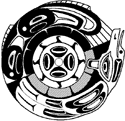 |
| Using a Planisphere (Middle School and up) |
Objective
To learn how to use a planisphere -- the projection on a plane of the celestial sphere;
learn to locate constellations, stars, and planets at any time of year. Students should
have practice reading a star map before this exercise.
Materials
- Planispheres
- Planisphere kits with instructions for audience to take with them.
Planetarium Set-Up
- Tonight's Sky
- Cardinal Points on
- Lights dim but bright enough to read
Introduction
The rotation of the Earth on its axis causes the stars to rise and set each
evening. In addition, the orbit of the Earth around the Sun places different
regions of the sky in our night-time view. A chart of the night sky will map the
locations of the stars; a planisphere will let us know which stars will be visible
during any time of night for any time of year. This exercise will help you
become acquainted with our night sky.
Procedure
Instruct the audience on the basic use of a planisphere:
"Position the planisphere so that the side with the opening is
facing you. Notice on the planisphere that the names of the constellations are given
in all capital letters and that the names of the stars are given in smaller letters.
Note, too, that the brighter the star is, the larger the circle."
"We are going to step through some exercises that will familiarize you with how
to use this planisphere. Some of these steps will be relatively easy; others may be
a bit hard. Please feel free to consult with your neighbors and ask me as many
questions as you wish!"
A number of people will have quite a bit of trouble with some of the following
exercises. Take your time. Walk around helping people; make sure most of the audience
has mastered a step in this exercise before moving on. You might wish to pause, at
any step, to demonstrate using the planetarium itself.
Exercises
- The horizon on the Earth is defined as what?
- The "oval" hole represents the sky. What part of this oval represents the
Earth's horizon?
- Note the outside of the star wheel with the months and days indicated.
Set the wheel to the month, day, and time of your birth. That is, line up
the time of day with the day and month. If you don't know the exact time, then set the
wheel for midnight.
- Point to the zenith (the place "straight up" on the planisphere and name a star
or constellation that was on or close to the zenith when you were born.
- As you look at the planisphere, does it seem as if West and East are
reversed? The planisphere represents a map of the sky. Hold the
planisphere as you would if you were really outdoors observing.
- Pretend you are facing North. How would you hold the
planisphere?
- Turn until you are facing West. What adjustment must you make
with the planisphere so that you can accurately read the map?
How about when you turn to face South or East?
- Find the North, East, South, and West horizons.
- What star was just rising in the eastern sky at the time you were born?
- What star was setting on the western horizon at the time you were
born?
- What constellation was on the northern horizon? The southern horizon?
The northeastern horizon? The southwestern horizon?
- Why is the North Star in the very center of the planisphere?
- If you were at the North Pole, where would you find this star?
- If you were at the equator, where would you find this star?
- What constellation is this star part of?
- Turn the planisphere counter-clockwise 360 degrees to represent the
passing of 24 hours. Note the date passes through all of the times on the
star wheel.
- What star doesn't seem to move at all?
- Name three constellations that never set from our location on Earth.
- Find the dashed-lin circle representing the ecliptic.
- Name four constellations the ecliptic passes through.
- The ecliptic represents the path of the Sun against the background
stars during the year. Turn the wheel so that it is noon on the day you were born.
What signs of the zodiac to you see?
- Name your favorite constellation.
- What constellation do you hope to find first in the sky?
- On the next clear night, go outside with your planisphere
and find your favorite (or any other) constellation!
Internet Resources:
Make your own Planisphere
Link to Otterbein College Department of Physics and Astronomy and a nice, sharp planisphere image
in PDF format that can be downloaded and printed. A planisphere is a more sophisticated map of
the sky and can be used as a "mini-planetarium." These "star wheels,"
usually designed for specific latitudes, can be turned to set the viewing area of the night sky
for any time and date. Planispheres are a special treat for children as they can set the star
wheel to the precise day and time of their birth (if known!) and see what constellations were in
the sky.
The Night Sky on Paper
"http://my.voyager.net/stargazer/starmap.html"
Using a Naked-Eye Sky Map
by Alan MacRobert of Sky & Telescope
Star Finding with a Planisphere
by Alan MacRobert of Sky & Telescope.

